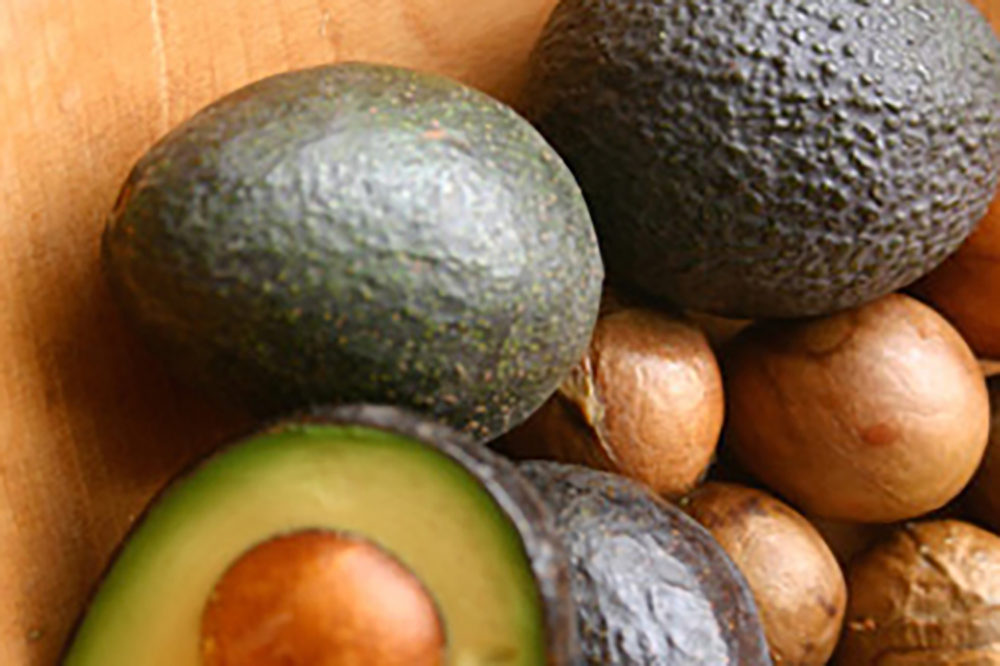
Plant Dye from Avocado Pits
Source: Sasha Duerr, Permacouture Institute

Recipe Type: Projects | Seasons: Autumn, Spring, Summer, Winter
A version of this recipe was demonstrated for Foodwise’s Market to Table program on May 17, 2014.
Natural dye materials can be sourced directly from your kitchen, garden, or even urban neighborhood. A perfect example of a natural dye that applies gorgeous color and transforms waste into wonder is the avocado pit.
The following recipe calls for an optional mordant. A mordant is a metal or plant-based fixative used to extend light, color, and wash-fastness for natural dyes. Some mordants can alter or change the plant color entirely. In the case of avocado pits, the tannin in the seed acts as a mordant that binds well to cotton fiber. Avocado pits produce light- to deep-pink shades and russet reds with no mordant added. When an iron solution is added, the color will transform into inky blues, purples, and blacks. Applying an iron after-bath to your pink and russet red dyed fiber can also allow you to resist-pattern and dip-dye your fabrics for awe-inspiring effects.
WHAT YOU WILL NEED
Well-washed 100-percent natural undyed wool, silk, cotton, linen, or other natural fiber
pH-neutral washing soap (eco-friendly dish soap works great)
Heat-resistant gloves
Nonreactive stainless-steel cooking pot with lid reserved just for dyeing (thrift stores and garage sales are great places to find affordable stainless-steel dyeing pots!)
Nonreactive stainless steel tongs reserved just for dyeing
3 to 5 fresh and cleaned avocado pits per ½ pound of fiber (more pits will produce a stronger, deeper color)
Iron mordant solution (optional; use if you want dark colors)
PREPARATION
Gather enough fabric or fiber for your project. Pre-wash and soak it in hot to warm water with pH-neutral soap. The fabric can be left to soak overnight to best take the dye evenly. It can be placed wet into the dye pot.
Fill your stainless steel dye pot with enough water to cover your material and have enough room for the material to freely move in the pot.
Add the whole avocado pits; the more pits, the darker and richer the hue and intensity of color will be. Do not cut or crush the pits. Bring to a low boil, then reduce the heat to a simmer. Simmer until the avocado pits begin to turn the water to pink and then a deep maroon. The color change will be visible in approximately 20 to 60 minutes. The deeper the color, the more vibrant the dye will be on your fabric. For darker color, the dye can be taken off the burner once the color has deepened and left to steep overnight.
Your material can be immersed in the dye pot either while the dye is still simmering over the heat or after the dye has steeped and cooled. Let your material soak in the dye bath for a minimum of 10 minutes. The longer the fabric soaks, the more vibrant the pinks and russet reds will be.
When the material reaches your desired shade, remove it from the dye pot with your stainless steel tongs. Rinse it in warm to cool water with pH neutral soap. Hang it to dry in the shade.
Applying the iron mordant (optional): You can make your own iron solution with rusty nails and water and a tiny bit of vinegar, or use iron powder. Only 2% of iron powder to weight of fiber is needed (a little goes a long way!). The solution can be used cold as an after-mordant. Let the fabric or fiber soak in the iron solution for at least 15 minutes for the best bond. Rinse in cool water and pH-neutral soap. Hang to dry in the shade.
For more information, see The Handbook of Natural Plant Dyes (Timber Press).
Farmers Market Ingredients

